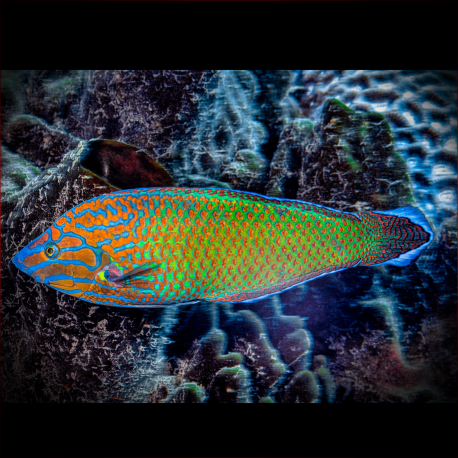More info
Datasheet
| Minimum Tank Size | 264 litres / 69.74 US gallons |
| Maximum Size | 15.2cm / 5.98inches |
| Reef Compatible | Yes |
| Temperament | Peaceful |
| Care Description | Moderate |
| Specific Gravity | 1.020-1.025 |
| Carbonate Hardness | 8-12 |
| pH | 8.1-8.4 |
General Description
The Grey Head Wrasse, also known as the Threespot Wrasse, is characterized by three white lines on each side of its head, three black spots along its back, and three false "eyes" along its dorsal fin extending to a fourth on the tail in juveniles and females. Adult males of this species feature vibrant blue stripes on their faces and orange/red spots along their bodies.
Aquarium Suitability
This species thrives in a minimum 70-gallon aquarium with a secure lid, a sandy substrate of 2-3 inches for shelter, and the company of peaceful wrasses, including conspecifics. While it preys on fireworms and pyramidellid snails, it poses no threat to corals or clams. However, larger individuals may target small ornamental shrimp and crabs, as well as feather dusters, wild shrimp, tubeworms, and flatworms. The Grey Head Wrasse serves as a useful tank-mate for parasite control and should be fed a varied diet of vitamin-enriched frozen mysis shrimp, brine shrimp, marine flake, and pellet foods.
Care and Hardiness
This wrasse exhibits moderate care requirements and is generally peaceful in temperament. Maintaining stable water conditions with a preferred pH range of 8.1-8.4, a specific gravity of 1.020-1.025, and a carbonate hardness (KH) of 8-12 dKH supports its well-being.
Reef Suitability
Considered reef-compatible, the Grey Head Wrasse does not harm corals or clams, making it a suitable addition to reef aquariums.
Aquarium Setup
To foster a thriving environment for the Grey Head Wrasse, aquarists should provide ample hiding spots with live rock formations, a sandy substrate for burrowing, and a well-maintained water quality system. Ensuring the tank has peaceful tankmates and appropriate feeding options contributes to the overall well-being of the species.
Behaviour
The Grey Head Wrasse exhibits peaceful behavior within its community, and its activity often involves foraging for food and interacting with tank mates. Its striking appearance and interesting behaviors make it a captivating addition to marine aquariums.
Feeding and Diet
As a carnivorous species, the Grey Head Wrasse consumes a diet rich in protein. Offerings of vitamin-enriched frozen mysis shrimp, brine shrimp, and other meaty foods, as well as high-quality marine flake and pellet foods, help maintain its health and vibrancy.
Habitat and Distribution
The Grey Head Wrasse, scientifically classified as Halichoeres leucurus, inhabits coral reefs in various regions. Its distribution includes specific areas where optimal conditions for its survival are met.

